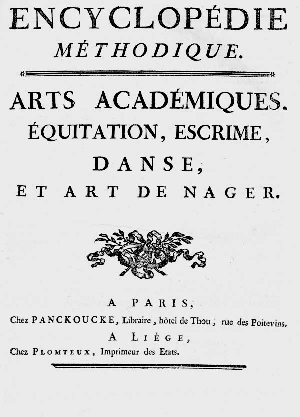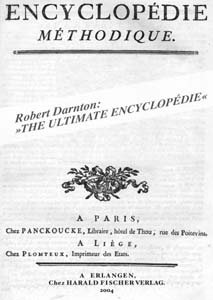Encyclopédie méthodique

Encyclopédie méthodique 1782 - 1832
Panckoucke: Lille, Paris, later Paris
206 volumes with 125,350 pages of text and 6,300 tables
(Archive of european Lexicography. 1: Encyclopedias; 50)
1,507 microfiches, 2004, ISBN 3-89131-453-1
Silver (negative): EUR 9,360.–
Content | Price list
Parts of the Collection now available online. All others can be ordered as PDF on demand.
Companion volume to the Microfiche Edition:
Harald Fischer: Die Encyclopédie méthodique. Zum
Inhalt und Aufbau des Werkes. 140 pages, ISBN 3-89131-414-0, EUR 20,–
Pankoucke, Charles-Joseph. 1736 – 1798
Pankoucke was, from 1768 onwards, the official publisher of both the Imprimerie Royale and the Académie Royale des Sciences. At the end of the 18th Century with such important works as Journal des savants, Mercure de France, L'Année littéraire and a series of famous authors he became the dominant figure in French publishing. In 1768 he became involved in the famous Encyclopédie from Diderot and d'Alembert publishing the supplementary volumes and doing, on the whole, very good business. Deveria, a small publisher from Lille, was the originator of the idea to eradicate the weaknesses and mistakes in the Encyclopédie with a new methodical work, the Encyclopédie méthodique. At first Pankoucke ridiculed this project but then sensing serious competition he took over the idea and made it his own and in the end calling the new Encyclopédie: un superbe ouvrage et la vraie Encyclopédie. The first volumes of the Encyclopédie méthodique were published in Paris and Lille (by Plomteux) in 1782. After 1790 it was only published in Paris.
Up till January 1794, when Pankoucke sold his business to his son in law Henri Agasse, somewhat more than 100 volumes, and so half of the entire work, were in print. The enormous Encyclopédieméthodique was a source of fame and honour for Pankoucke but not of money. As a result of the Revolution the original 5,000 subscribers had been reduced by 90 percent. The economic development of the project later led Pankoucke's daughter to say of the Encyclopédie : «l'entreprise la plus vaste du dix-huitième siècle ... enterprise au-dessus des forces d'un simple particulier, et quia coûté à son éditeur sa fortune, sa santé, et sa vie.» After Agasse's death in 1813 his wife took over the project. The last part of the work, volume 3 of the section Histoire naturelle des Vers, appeared in 1832.
Encyclopédie méthodique

The alphabetical sorting of the entries as practised in the old Encyclopédie separates related thoughts and places unrelated subjects next to each other. This Confusion des objects makes it impossible for the reader to investigate and absorb all the various aspects and divisions of an object, a technique, an art or a science together in one context. Pankoucke's aim was to correct this methodological mistake of the «old» Encyclopédie. In order to do this, each discipline was to receive its own Dictionnaire with articles systematically and exhaustedly presenting the areas of knowledge. The large number of editors led to variations in the realisation of this aim. There are complete dictionaries for all of the more than 50 areas of knowledge, which were handled, this alone can be regarded as a major achievement in publishing. For some disciplines there are also extra complete systematic presentations and some editors realised Pankoucke's instructions in an exemplary way: Arts et Métiers Mécaniques consists of 8 volumes with approximately 500 detailed articles. The separate articles, for example Arts du PERFUMEUR, consist of up to 60 pages and each closes with a small subject relevant vocabulary. At the end of each volume is a list of the articles, which it contains. Roland de la Platière proceeded similarly in the second section of the Arts et Métiers that is the Manufactures, Arts et Métiers.
Classification
It is an interesting question as to how the knowledge of the period was classified, into
how many sections and in which order. Pankoucke included in Vol. 1 Beaux-Arts (1788),
Vol. 3 Mathematiques (1789) and Vol. 5 Histoire (1791) a prospectus describing
the aims and classifications of the Encyclopédie méthodique and its publishing
progress. It was originally conceived with 27 sections. The prospectus from 1789 names 49
sections with 51 Dictionnaires and the prospectus from 1791 54 Dictionnaires. Because
each section is not exactly one Dictionnaire and vice versa information concerning the number
of sections in the literature is often confusing. So the four volume section Logique et
Métaphysique has as well as the actual dictionary Logique et Métaphysique a
complete dictionary on the subject Morale and a further one on the subject
Education.
The confusion over the number of volumes is even greater because other parts are bound into
each of the still existing copies.
In Pankoucke's prospectuses the ordering of the sections begins with Mathematiques and
ends with Artset Métiers Mécaniques thus proceeding from the theoretical to practical
knowledge. Beyond this there are a number of other meaningful classification
possibilities.
Unlike earlier encyclopaedia where the Tree of Knowledge served as the symbol for
systemisation here it is the modern university with its independent faculties and institutes,
which fills this role. This autonomy of the disciplines and other subsections is an important
feature of the Méthodique.
Size
Without any claims of finality we count approx. 60 complete Dictionnaires in 206 volumes. The Encyclopédie méthodique contains circa 125,350 pages of text with circa 6,300 tables. Thus it is twice as large as Zedler's Universallexikon (68,000 pages) and five times as long as the Encyclopédie from Diderot and d'Alembert (25,000 pages).
Contributors
It is less the philosophers, literati, and universalists but rather more a new younger generation of practical workers, inspectors, doctors, natural historians and engineers who build the centre of the circle of contributors to the Méthodique. Their academic qualifications are presented in great detail on the title pages. According to Darnton, Pankoucke had won the finest talent of his time for his Encyclopédie. Linné and Lavoisier, Lamarck and Vicq d'Azyr were the creators of the new standards for science, which were then documented in the Méthodique. Pankoucke's special interest for science, craft and technique cannot be overseen. However there are contributions in the humanities of continuing value today from, for example, Beauzée (Linguistics), Bergier (Theology), Naigon (Philosophy), Watelet (Fine Art) and Framery (Music).
Tables
All of the sections on the crafts, fine arts and sciences have a fill of beautiful
illustrations. The illustrations as far as they are separate, and do appear not collected in
their own volumes, are printed at the end of the text to which they apply. The text volumes
contain detailed descriptions of the illustrations.
Terra incognita
The search for the Encyclopédie Méthodique brought out some surprises into the daylight. Some libraries had not noticed that the two encyclopaedia are two completely separate works. That the names of Diderot and d'Alembert appear at the front of the Méthodique may have contributed to the confusion. The long period of time, which it took for it to appear and the diversity of the themes made it difficult to assemble a complete edition. A lack of knowledge as to what actually belonged to the Méthodique made certain attributions difficult. For these reasons very few libraries own a complete edition of the Encyclopédie méthodique.
Up to the present day the Méthodique has stood in the shadow of the much smaller Encyclopédie of Diderot and d'Alembert. A judgement, which it appears, is finally reversing. The Encyclopédie méthodique documents a period of revolutionary change – in academia and culture, in society and politics.